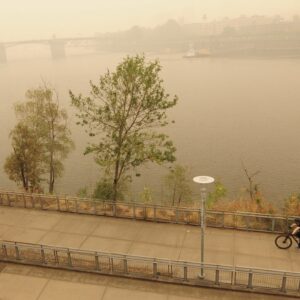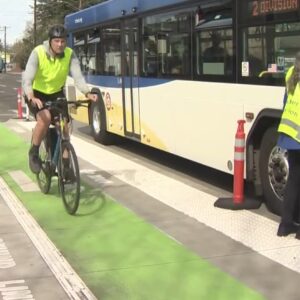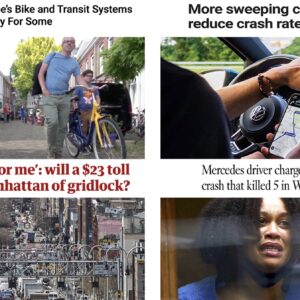
Photo: haljon/Flickr
A recent interview I published about an effort to change the laws around how bicycles treat stop signs touched of an engaging and lengthy debate (92 comments so far).
In reaction, this is the first of two posts I will publish to present different perspectives on the proposed law change.
This first one is in support of allowing bicycles to treat stop signs as yields. The eloquent argument comes from newbie bike commuter David Dean (who originally left it as a comment):
“I did my first Portland bicycle commute after my car was stolen Monday night. I live near McMenamin’s Kennedy School and my job is in the Hollywood district. I have two options: I can go down NE 33rd and try to wedge myself between an endless and very dangerous stream of traffic and parked cars, or go down the neighborhood roads and encounter a stop sign every other block.
“Cars, bicycles, and pedestrians are all very different forms of transportation and the law should respect those very obvious differences.”
–David Dean
Cars don’t use the neighborhood roads because of the stop signs and I don’t want to use the thoroughfares because of the cars. So I’m left with the stop signs and mostly empty intersections.
Once a cyclist stops it is very difficult and time consuming to start again, especially on a hill. From a stop, a pedestrian can typically move through a narrow neighborhood intersection much more quickly than a cyclist, and if the pedestrian is slow, they are afforded the right of way. On a bicycle at a two way stop, after waiting for traffic to clear, by the time I reach the other side of the intersection I could have a speeding car bearing down on me. A speeding car can plow me over and legally I would be at fault!
Slowing down to observe the intersection while maintaining enough momentum to quickly get through the intersection is the safest way for a cyclists to approach most neighborhood intersections. Cars, bicycles, and pedestrians are all very different forms of transportation and the law should respect those very obvious differences.
“The law is clearly written for the safety and convenience of cars and pedestrians, as most voters and lawmakers fall into those two categories on a daily basis.”
The law is clearly written for the safety and convenience of cars and pedestrians, as most voters and lawmakers fall into those two categories on a daily basis. Cyclists are an overlooked and under protected minority class.
Relaxing the existing law isn’t going to cause anyone to behave recklessly on a bicycle. If reckless cyclists don’t care about their own personal well being, why would fines change their behavior? We could use the “law as a deterrent” argument to justify any overly harsh and otherwise ridiculous law.
As a new and very conscientious cyclist, I would feel safer if I could treat stop signs as yields I want to be safe, I want you to be safe, and the best way to accomplish that is to change the law.”
Stay tuned for a different perspective on this topic…





As far as the physics go, this article from Berkeley explains the trouble with stop signs.
And I guess I should also note that David is pretty much describing the need for bicycle boulevards — through streets without stop signs that have some engineering or other disincentive to limit speeding cut-through car traffic.
That’s really the key – remove the stop signs and you encourage auto traffic once the cars figure out there are no stop signs. There has to be some kind of disincentive to speed down the street, or cars will take over those roads to the exclusion of everyone else.
I heard yesterday about a bill being proposed that would limit speed on narrow streets to 15mph instead of 25mph. I think it is a good idea for bike boulevards too, many cars would move over a block if the speed limit was 10 mph higher.
Bjorn
This is off topic to some extent, but in response to #3. Matt your statement about cars taking over is true only if the boulevards are poorley designed.note that Evan mentioned “… that have some engineering or other disincentive to limit speeding cut-through car traffic.” What he is getting at is properly designed boulevards will force cars off the boulevard regularly. Some good examples of traffic calming measures would be, 21st and Ankeny, bikes can remain on Ankeny but cars must turn onto 21st. Another example of cars being forced off route would be NE16th one block north of broadway, bikes can continue on 16th but cars are forced to turn towards fifteenth. This law might make it easier to create new bike boulavards without as many large traffic calming measures. Stop signs would act in combination with signage and some larger calming measures to deter auto traffic while letting bikes travel through with a minimum of full stops.
JayS.
I agree with Evan Manvel, the real solution is to have bike boulevards.
I will try to find a link but I saw a fascinating bit on CNN (?) about a town of 20,000 people in Europe (I think it was in Belgium) that ELIMINATED traffic lights and stop signs. Of course, everyone thought this would be a complete disaster leading to multiple accidents and pedestrian / cyclist deaths.
A funny thing happened, everyone using the roads(drivers, cyclists, peds) became very paranoid and very careful once the controls were gone. Then a long-term behavior change took place as a result: road users starting actually paying attention to their surroundings and began exercising more courtesy. The end result was that accidents actually decreased! Now, traffic engineers are flocking to this burg to study how it works and if it can be applied to larger traffic models.
Perhaps emphasizing personal responsibility rather than control is the answer? Maybe the sheer amount of control mechanisms actually discourages active thinking while behind the wheel?
The so-called “naked street” movement removing stop signs and just about all other kids of signs seems like a good one for Portland. If you’re interested, David Engwicht’s latest book “Mental Speed Bumps” describes the efforts Hans Monderman and a whole lot about driver behavior. A more technical publication about naked streets can be found at:
http://www.hamilton-baillie.co.uk/papers/14_TEC.pdf
(and don’t forget Wikipedia, as well)
NO!!!!!!!!!!!!!!!!!!!!!!!
Stop signs and red lights have to mean the SAME THING FOR EVERYONE!!!!!!!!!
If we want to be treated well by drivers and the legal system, our behavior on the road has to be squeaky clean. Until we don’t have a completely autocentric traffic environment and vehicle legal code, we just have to be that way.
This is a great idea, as it codifies into law what is now a very ambiguous situation, as many cyclists themselves aren\’t sure what to do (particularly if they are new riders).
By giving clear-cut rules of the road, as long as everyone is aware of them, it should make things safer for EVERYBODY.
I think this is one of the reasons bicycling is so popular in Europe – they are extremely consistent with how bicycles are integrated into the street network; I saw few scary intersections like we commonly have in the US. Of course, Europeans are also control freaks, but that\’s another topic. 🙂
David Dean\’s argument for why cyclists shouldn\’t be required to full stop at stop signs seems one-sided to me, and dangerous. Motor vehicle drivers especially need to know, when they approach, or are at a stop sign, what a cyclist near or approaching them from a number of possible directions is going to do.
They need to know this so they can decide when it\’s safe to get their own very heavy vehicle rolling again, or whether to stop it if it is rolling. If there\’s some question about whether the cyclist has to stop or not, it seems like big problems could occur as a result.
That city without stop signs concept is an interesting one to ponder. Sometimes when the power goes out in winter, it\’s possible to get a sense of how that might work. Smaller intersections of two-lane, two-way roads, it works pretty good if everyone is alert, paying attention and can see well enough to know what all the other road users are doing. Big intersections like Burnside and Grand are a mess. I had a fender bender there years back in just such a situation. Portland is not a small town of 20,000 people.